A Year at Sutton Ridge: Visit 2 – Budburst
Written by Diana Lyalle
There is a quiver of excitement in vineyards the world over when the bare skeletons of pruned vines suddenly reawaken after their long winter rest. Despite the many vineyard tasks and eternal vigilance which will now be needed to reap rewards at harvest, budburst (aka budbreak) represents the promise of the forthcoming vintage, especially exciting this year in Somerset after the bumper quality crop in 2018. Each bud contains everything the vine needs – new shoots, lush leaves, tendrils for clinging, and clusters which will bring forth flowers, and hopefully, lots of healthy grapes.
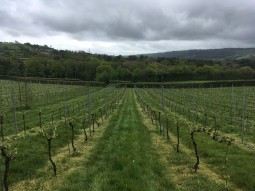
So you can imagine how it felt to gaze over the gate upon the Pinot Noir vines we pruned last month, now tied down and, quite literally, bursting into life.
Apart from a rogue bud here and there, budbreak didn’t get going properly until Easter Monday (21st April) or thereabouts. It doesn’t all happen on one day of course, different varieties reacting to warming temperatures at different rates, but the “window” was around then, brought on by very warm weather over Easter preceded by a decidedly cool spell which had slowed things down. Luke thinks this is around about the usual time. Compared to spring in our gardens which has been long established, vineyard spring seems surprisingly late.
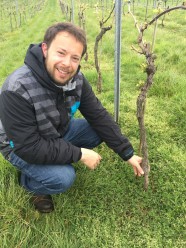
The weather since my last visit had been largely dry until this week, so the canes were unusually brittle and some snapped off when tied down. Other than than, as you can see, Luke seems pleased with progress so far. He aims for buds about a fist length apart on the canes to give enough room for air to circulate in the canopy. He also wants to see plenty of life from the “thumbs” we left for next year’s canes.
The most feared weather hazard from this point is frost. Early budburst facilitates a long growing season allowing complex flavours to build up in the grapes, essential for quality wine. However, it comes with greater frost risk. In the UK, on balance, later budburst lessens the frost risk and we have such a long growing season that there is usually plenty of time for the grapes to develop.
Sutton Ridge’s position in the Yeo Valley, its south easterly aspect and its location in the relatively mild south west of England is such that the frost risk is less than many other UK sites. Luke could lessen the risk further by taking anti-frost precautions if frost is forecast, but these are expensive so he takes his chances, aided by late pruning (see previous blog) which helps to push back budburst slightly later than elsewhere.
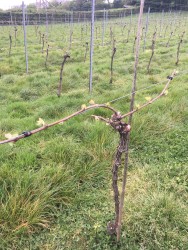
Other than site selection and late pruning, there isn’t much grape growers can do to control when budburst happens. The process begins when the soil warms up to around 10°C which prompts the vine’s roots to send sap upwards through the trunk to the latent buds. Pruning also prompts sap to rise, but only if the soil is warm enough. Carbohydrate reserves (sugars and starch) stored in the roots, trunk and canes fuel the process. Minute root hairs explore tiny fissures in the soil, extracting nutrients and moisture as they grow – some grow to become roots. In colder wetter conditions these root hairs don’t develop so easily which delays budburst. So even though we can’t see what happens beneath our feet, budburst is evidence that something must be going on!
Although climate change is having an impact on UK vineyards, as Stephen Skelton MW says in his “Viticulture” textbook, the main vineyard milestones of budburst, flowering, véraison and harvest are still occurring more or less at the same time each year. There are annual variations of course, and Luke told me that last year flowering, expected in Wimbledon fortnight, happened ten days early. Judging by this year’s weather to date, he does not expect early flowering this year.
Luke has already sprayed the vines against disease just before budburst, and he expects to spray the vines every fortnight or so from now on i.e. 8-10 times during the growing season because if mildew sets in it is hard to get rid of it. The timing of the next spray depends on the weather – if it remains soggy as it is at present, spraying will happen sooner rather than later.
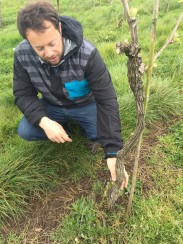
Other tasks include moving the wires downwards so they can be more easily adjusted around the vines as they grow, and rubbing off unwanted buds from the trunks so the vine’s efforts are directed towards the fruiting canes.
Luke also wants to remove secondary buds, again to concentrate the vine’s efforts into the best shoots. But a secondary bud can be a useful Plan B if frost strikes, so Luke will wait until they are longer and the frost risk is much lower before he loses them.
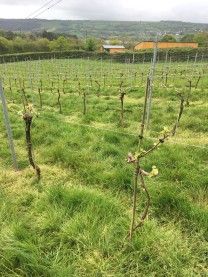
With discernible pride, Luke pointed out a new vine created from a neighbouring cane to replace a vine he lost. It had been bent across, trained downwards, allowed to take root and then been set free from its parent such that it was now growing up by itself. A vine teenager, if you will. It does not have roots resistant to the predations of the phylloxera louse, but it makes a useful stop gap and seems pretty perky so far.
As for what is new outside the vineyard, Luke was proud to announce that his Dewdown sparkling white wine was awarded silver in the IEWA (Independent English Wine Awards) competition, and he plans to enter his wines in Wine GB again this year – last year his 2017 Rosé won Gold – remarkable for what is a boutique vineyard without the resources of others with similar accolades.
The eagerly awaited 2018 Bacchus white wine and the rosé are now available and I can’t wait to taste them. Watch this space for a comparison of the 2017s and 2018s, and also a comparison of my tasting notes of the 2017s this time last year with notes one year later to see how they have developed in bottle.
I will next be visiting Sutton Ridge in Wimbledon fortnight for flowering so here’s hoping jack frost has made his last appearance for some time.

No comments yet.